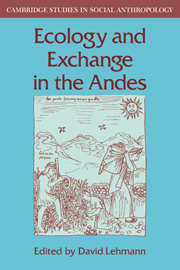Book contents
- Frontmatter
- Contents
- List of contributors
- Acknowledgements
- The Andean region: relief
- The Andrean region showing ecological levels (after Troll 1968)
- 1 Introduction: Andean societies and the theory of peasant economy
- 2 The role of the Andean ayllu in the reproduction of the petty commodity regime in Northern Potosí (Bolivia)
- 3 Labour and produce in an ethnic economy, Northern Potosi, Bolivia
- 4 ‘Resistance to capitalism’ in the Peruvian Andes
- 5 Production and market exchange in peasant economies: the case of the southern highlands in Peru
- 6 The Andean economic system and capitalism
- 7 Property and ideology: a regional oligarchy in the Central Andes in the nineteenth century
- 8 Multi-levelled Andean society and market exchange: the case of Yucay (Peru)
- Glossary
- References
- Index
- Cambridge Studies in Social Anthropology
5 - Production and market exchange in peasant economies: the case of the southern highlands in Peru
Published online by Cambridge University Press: 29 September 2009
- Frontmatter
- Contents
- List of contributors
- Acknowledgements
- The Andean region: relief
- The Andrean region showing ecological levels (after Troll 1968)
- 1 Introduction: Andean societies and the theory of peasant economy
- 2 The role of the Andean ayllu in the reproduction of the petty commodity regime in Northern Potosí (Bolivia)
- 3 Labour and produce in an ethnic economy, Northern Potosi, Bolivia
- 4 ‘Resistance to capitalism’ in the Peruvian Andes
- 5 Production and market exchange in peasant economies: the case of the southern highlands in Peru
- 6 The Andean economic system and capitalism
- 7 Property and ideology: a regional oligarchy in the Central Andes in the nineteenth century
- 8 Multi-levelled Andean society and market exchange: the case of Yucay (Peru)
- Glossary
- References
- Index
- Cambridge Studies in Social Anthropology
Summary
The peasant communities of the Andes constitute a ‘reality without a theory’. Despite their undoubted importance in most Andean countries, there are as yet no satisfactory accounts or explanations of their economic functioning and dynamics. In this chapter I shall present an analytic framework to study their process of production and exchange. The peasant community is analysed here in the same terms as one might analyse a national economy, with an internal and external sector, production divided into sectors and technological and trade relations between them. This permits us to describe the production structure and the net result of exchanges between the community and the rest of the economy, showing the relative importance of wage labour, self-consumption and exports in the generation of peasant incomes, and thus their degree of market integration.
I shall apply that framework to the peasant families living in communities in the southern highlands (sierra) of Peru. This is the most ‘traditional’ and poorest social group in Peru, where conventional views characterize them as ‘self-sufficient’ economies, ‘outside-the-market’. This study shows empirically the degree and mechanisms of market integration of these communities, which constitute the present historical form of the peasant economy in Peru.
The analytical framework
Technological and market relations
The peasant community is not only an aggregate of families but a social context which establishes certain economic relationships among its members, in which certain economic decisions are reached collectively and certain economic activities are carried out collectively.
- Type
- Chapter
- Information
- Ecology and Exchange in the Andes , pp. 123 - 156Publisher: Cambridge University PressPrint publication year: 1982
- 5
- Cited by



